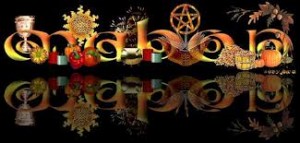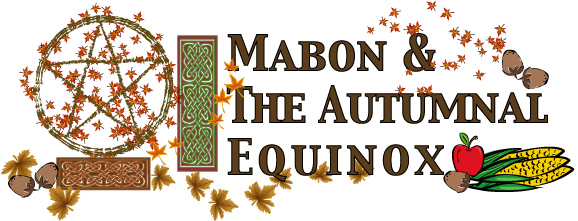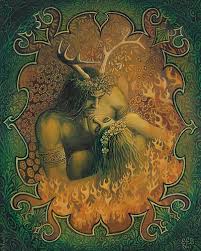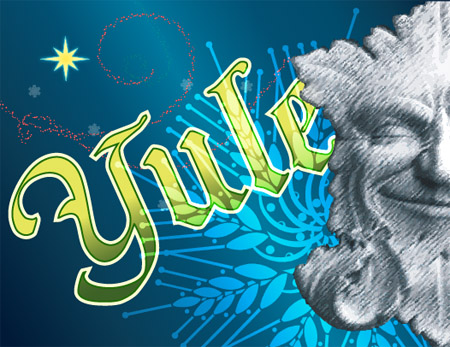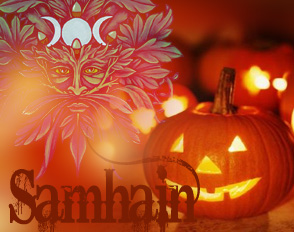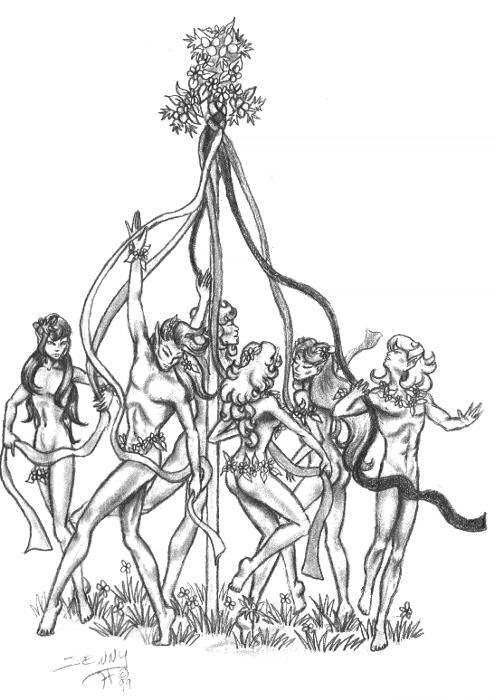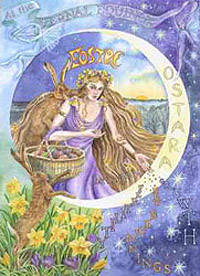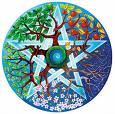(February 1st – 2nd)
The Festival of Lights
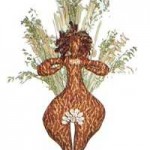
Imbolc, (pronounced “IM-bulk” or “EM-bowlk”), also called Oimealg, (“IM-mol’g) by the Druids, as is the festival of the lactating sheep. It is derived from the Gaelic word “oimelc” which means “ewes milk”. Herd animals have either given birth to the first offspring of the year or their wombs are swollen and the milk of life is flowing into their teats and udders.
Imbolc is one of the four greater Sabbats, celebrated on February 2nd. It is to celebrate the first stirrings of spring. It is the time of blessing of the seeds and consecration of agricultural tools. This is when the first buds can be seen appearing on trees, and in many places the first Crocus flowers begin to spring forth from the frozen earth in the Northern Hemisphere. It is when the days are quite visibly longer than they were around Yule, and they are of somewhat bearable temperatures, as it marks the center point of the dark half of the year.
Religious Myth
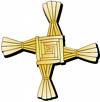
On this Sabbat Pagans honor the Goddess in her Maiden aspect, as the bride, for from this day to March 21st, it is her season to prepare for growth and renewal. Brighid’s snake (Kundalini energy) emerges from the womb of the Earth Mother to test the weather, (the origin of Groundhog Day).
Traditionally, celebrants honor Brigid, who has many names; she’s known as Brighid, Bríde, Brigit, and Brìd. In Her honor, the Irish call the Imbolc holy day “Lá Fhéile Bríde” (the Feast of Bride), the Scottish “Latha Fhèill Bríghde” (the Festival of Brigid), and the Welsh say “Gwyl Ffræd” (Brigit’s Feast). Her element is fire. She inspires the mind to create poetry. Brigid blesses holy wells, healers and blacksmiths, and Her symbol is a weaving of straw called a Brigid’s Cross, fashioned from wheat stalks and exchanged as symbols of protection and prosperity in the coming year. You can find these Celtic talismans blessing doorways all over Ireland. She is the Triple Goddess — Maiden, Mother, and Crone — who offers us light in the season of darkness. Also, Straw Brideo’gas or Corn Maidens (corn dollies) are made from corn, oat or wheat straw, dressed up and placed in cradles or baskets with white flower bedding known as “Bride’s Bed”. Young girls then carry the Brideo’gas door to door, and gifts are bestowed upon the image from each household. Afterwards at the traditional feast, the older women make special acorn wands for the dollies to hold, and in the morning the ashes in the hearth are examined to see if the magic wands left marks as a good omen. The dolls are generally kept year round as a symbol of fertility. Home hearth fires are put out and re-lit, and a besom is place by the front door to symbolize sweeping out the old and welcoming the new. Candles are lit and placed in each room of the house to honor the re-birth of the Sun.
That said, this season belongs to Brigid, the Celtic goddess who in later times became revered as a Christian saint. Originally, her festival was on February 1, but the Catholic Church later replaced this festival with Candlemas Day on February 2, which is dedicated to the Virgin Mary and features candlelight processions.
Another traditional symbol of Imbolc is the plough. In some areas, this is the first day of ploughing in preparation of the first planting of crops. A decorated plough is dragged from door to door, with costumed children following asking for food, drinks, or money. Should they be refused, the household is paid back by having its front garden ploughed up. In other areas, the plough is decorated and then Whiskey, the “water of life” is poured over it. Pieces of cheese and bread are left by the plough and in the newly turned furrows as offerings to the nature spirits. It is considered taboo to cut or pick plants during this time.
Various other names for this Greater Sabbat are Imbolgc Brigantia (Caledonni), Imbolic (Celtic), Disting (Teutonic, Feb 14th), Lupercus (Strega), St. Bridget’s Day (Christian), Candlemas, Candlelaria (Mexican), the Snowdrop Festival. The Festival of Lights, or the Feast of the Virgin. All Virgin and Maiden Goddesses are honored at this time.
Celebration
Imbolc is a festival of light, reflecting the lengthening of the day and the hope of spring. It is traditional to light all the lamps of the house for a few minutes on Imbolc, and rituals often involve a great deal of candles.
Now is the time to wear white, go for long walks through the snow and search for signs of spring, and for honoring the maiden goddess. It is a time of personal growth and renewal. Do some spring cleaning, meditate, have a cleansing bath.
Imbolc Lore
Deities of Imbolc: All Virgin/Maiden Goddesses, Brighid, Aradia, Athena, Inanna, Gaia, and Februa, and Gods of Love and Fertility, Aengus Og, Eros, and Februus.
Symbolism of Imbolc: Purity, Growth and Re-Newal, The Re-Union of the Goddess and the God, Fertility, and dispensing of the old and making way for the new.
Symbols of Imbolc: Brideo’gas, Besoms, White Flowers, Candle Wheels, Brighid’s Crosses, Priapic Wands (acorn-tipped), and Ploughs.
Herbs of Imbolc: Angelica, Basil, Bay Laurel, Blackberry, Celandine, Coltsfoot, Heather, Iris, Myrrh, Tansy, Violets, and all white or yellow flowers.
Foods of Imbolc: Pumpkin seeds, Sunflower seeds, Poppyseed Cakes, muffins, scones, and breads, all dairy products, Peppers, Onions, Garlic, Raisins, Spiced Wines and Herbal Teas.
Incense of Imbolc: Basil, Bay, Wisteria, Cinnamon, Violet, Vanilla, Myrrh.
Colors of Imbolc: White, Pink, Red, Yellow, lt. Green, Brown.
Stones of Imbolc: Amethyst, Bloodstone, Garnet, Ruby, Onyx, Turquoise.
Activities of Imbolc: Candle Lighting, Stone Gatherings, Snow Hiking and Searching for Signs of Spring, Making of Brideo’gas and Bride’s Beds, Making Priapic Wands, Decorating Ploughs, Feasting, and Bon Fires.
The Rituals
– I –
Typical Wiccan Imbolc ritual
The Altar should be provided with:
-a gold and a silver candle (lit)
-a cauldron filled with earth or salt into which eight unlit candles have been set. A white candle in the middle surrounded by (in order)a red, orange, yellow, green, blue, purple, and violet candle. The colored candles should form a circle around the white.
-Incense and burner (the incense should be cinnamon, you can just use regular cinnamon on a charcoal disc)
Tools:
-Consecrate a circle and call the quarters.
-Recite the following Prayer:
This night the Mother sleeps in Winter
Dreaming of the Life to come
Clothed in silent white
She rests from the labour of birth
Born at Solstice, the Child Sun grows strong
Hear us, Child of the Mother
Bring to us the Fire of Life
-Take the gold candle and light the white candle in the center of the cauldron, then use the white candle to light the rest saying as you do:
Fire of Breath (violet)
Fire of Desire(purple)
Fire of Purity(blue)
Fire of Creation(green)
Fire of Knowledge(yellow)
Fire of Spirit(orange)
Fire of Life(red)
-Return the white candle to the center of the cauldron and say:
I stand in the center
My heart is a child’s
I celebrate the Seed
Awaken and grow
I stand in the center
My heart is a child’s
I celebrate the Seed
Awaken and grow
I stand in the center
My heart is a child’s
I celebrate the Seed
Awaken and grow
Sun’s Flame, Brigid’s Flame
Bring us light
Bring us life
Awaken the Mother
The time of Growth draws nigh
Sun’s Flame, Brigid’s Flame
Bring us warmth
Bring us growth
Awaken the Seed
To grow and prosper
Sun’s Flame, Brigid’s Flame
Bring us light
Bring us life
Bring us warmth
Bring us growth.
-Meditate on new beginnings and future plans, this is also a good time for initiations and consecrations.
-Snuff the candles when you are done. Close the Circle.
~ ~ ~ )0( ~ ~ ~
– II –
Tools:
In addition to your magical tools, you will need:
* A White Altar Cloth
* Light Green Taper Goddess Candle
* Light Yellow Taper God Candle
* 13 White 4″ Stick Candles
* Brideo’ga*
* Small Woven Basket with White Flowers
* Pentacle Candle Wheel
* Handful of Acorns
* Cauldron
* Snow/Crushed Ice
* Small White Pillar Candle
* Potpourri Holder
* Tea Lite
* Basil, Bay, Heather Flowers, Cinnamon and Vanilla Potpourri Blend
* Long Wooden Stick Matches
Preparation:
Sweep area, moving in deosil direction. Outline your circle with white cord Angelica leaves. Place Pentacle Candle Wheel in the center of altar. Place the lt. green taper Goddess candle to the top left of altar and the lt. yellow taper God candle to the top right of altar. Put the white flowers in the basket as bedding for the Bride’s Bed, then place the Brideo’ga atop the flowers. Place the basket in front of the Goddess candle, to the left of the Pentacle Candle Wheel. Place the acorns in front of the God candle, to the right of the Pentacle Wheel. Place the tea lite in the bottom of potpourri holder, and put holder at front center of the alter. Place white pillar candle in the middle of the cauldron, fill cauldron about 1″-2″ with snow or crushed ice, and position on floor in front of altar. Put the container with potpourri where it can be reached easily. Place the rest of your tools and props according to personal preference. Bathe or shower for purification. Ground and center. When ready, put on some soothing music associated with this Sabbat and your ritual.
Cast circle by holding out your right hand and tracing over the cord or leaves in a clockwise direction. As you trace over the outline envision flames of pure white rising up along the perimeter. When the beginning and the end join the circle is complete. Step up to the cauldron and light the white pillar candle, saying:
“Amidst the darkness the Lady is stirring,
Gently awakening from frozen dreams,
All the world has awaited this moment The return of the Maiden,
And Her promise of oncoming Spring.”
Call the Quarters.
As this is a time to honor Mother Earth as she wakes from her winter’s recovery of giving rebirth to the Sun King at Yule, start with North, the element Earth. Pick up the container of potpourri, step up to the altar and pour some into the holder, saying:
“Powers of Earth, the Maiden awakens!
Come join the circle and share in the light.”
Put the container back where it was. Light the white candle at the North point of the Pentacle Candle Wheel. Continue, by waving your hand over the potpourri as if to create a breeze on which to carry the scent, saying:
“Powers of Air, the Maiden awakens!
Come join the circle and share in the light.”
Light the white candle at the East point of the Pentacle Candle Wheel. Light the tea candle in the bottom of the potpourri holder, saying:
“Powers of Fire, the Maiden awakens!
Come join the circle and share in the light.”
Light the white candle at the South point of the Pentacle Candle Wheel. Pour some water into the holder with the potpourri, saying:
“Powers of Water, the Maiden awakens!
Come join the circle and share in the light.”
Light the white candle at the West point of the Pentacle Candle Wheel. Remove the white candle from the top point of the Pentacle. Since Akasha is the omnipresent, it need not be invoked. Light the candle and invoke the Goddess and the God by lighting the lt. green Goddess candle and the lt. yellow God candle with the white candle. Place the white candle back in the top point of the Pentacle Candle Wheel, saying:
“Be with me now, oh Ancients, eternal,
Hear now my prayers, hopes and dreams.
The Goddess has wakened, once more as the Maiden
By loving caresses from the strengthened Sun King.”
Light the inner cross points of the Pentacle Candle Wheel, starting with the cross point to the right of the North point. Light all 5 cross points in succession, saying:
“The Earth now grows warmer, as the Wheel again turns
And as each passing day adds strength, To the Sun King’s rays
The Maiden, of his gift of life, now silently does yearn.”
Take a couple of the acorns from in front of the God candle and place them in the Bride’s Bed with the Brideo’ga. Light the three aspects of the Goddess candles. All aspects are white because She is the Triple Goddess appearing as the Maiden, pure, and renewed. Step back from the altar and contemplate the light that is brought about by the re-union of the God and the Goddess saying:
“Behold the God and Goddess,
Lord of the Forest and his Bride,
Once again the Earth is blessed
With life anew inside.
Seeds shall soon begin to sprout
And creatures shall young bear
For this is the Promise, the Cycle of Life
That is born of the love They share.”
Now is the time for meditation and any spellworkings. Spellworkings associated with Imbolc include those for fertility, defining and focusing on goals for the future, organization, health, and protection. Next, celebrate with Cakes and Ale (Poppyseed Cakes* and Spiced Tea*) Ceremony, saving some for the wee Folkes, outside. Thank the God and Goddess for Their presence snuff their candles. Thank and release the Quarters, saying:
“Though you leave this circle, tonight,
Water, Fire, Air, and Earth
Your symbols shall linger on a while
Blessing my home and hearth.
The herbs that scent this room tonight,
Were chosen with loving care,
To bless me, my family and my friends,
And my sisters and brothers everywhere.”
Snuff each of the white candles at the directional points of the Pentacle Candle Wheel, starting with the candle at the top point first, then the West point and working in a widdershins direction. Snuff the inner cross point candles also in a widdershins direction. Finally snuff the three aspects of the Goddess candles. Step back from the altar and face the cauldron with the white pillar candle still burning brightly saying:
“I honor Thee, Maiden, most blessed Bride
As your candle burns through this night
And thank you for the renewed life you offer us all
As you emerge from the dark to the light.”
Release the circle. Clean up, place the cauldron from the floor onto the middle of the alter. Let the candle burn out by itself. Place the potpourri in a spot where its scent and blessings fill the house. You are done.
—————————————————————————-
*references*
The Witches’ Voice Inc.
http://www.celticspirit.org
http://www.wicca.com
http://www.mythicjourneys.org

